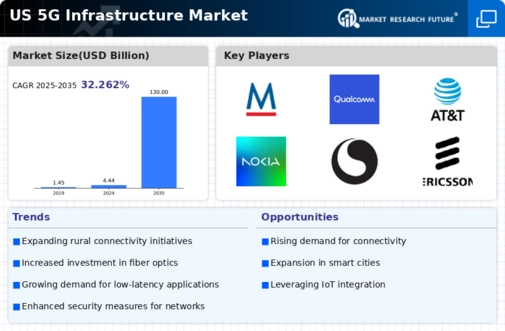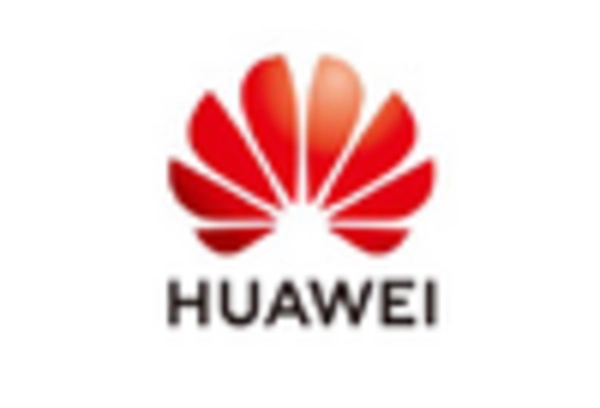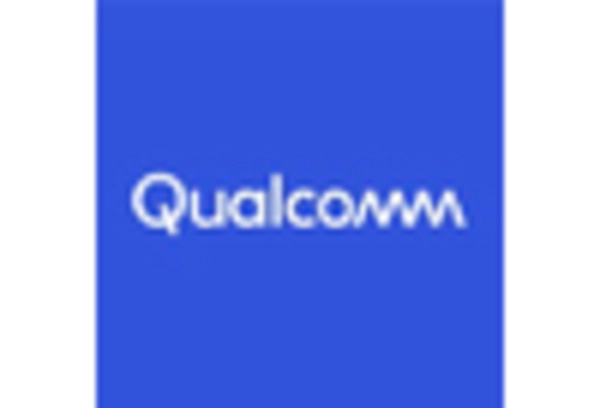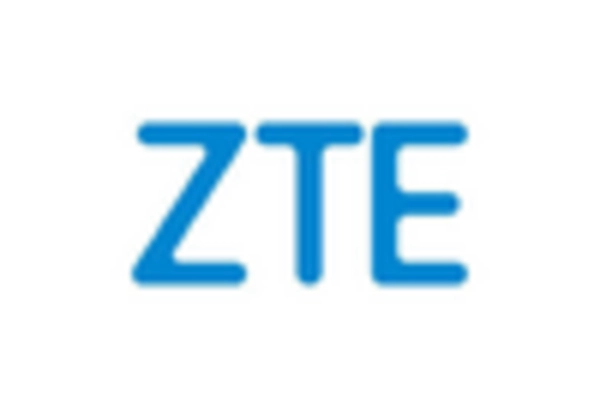Increased Adoption of IoT Devices
The increased adoption of Internet of Things (IoT) devices is driving the 5g infrastructure market forward. As more devices become interconnected, the demand for reliable and high-speed networks intensifies. In the US, it is estimated that there will be over 75 billion IoT devices by 2025, creating a substantial need for 5g infrastructure to support this ecosystem. The low latency and high bandwidth capabilities of 5g technology are particularly suited for IoT applications, ranging from smart cities to industrial automation. This growing reliance on IoT solutions necessitates the expansion of 5g networks, as businesses and municipalities seek to leverage the benefits of connectivity. Therefore, the increased adoption of IoT devices is likely to be a key factor in the ongoing development of the 5g infrastructure market.
Government Initiatives and Funding
Government initiatives and funding play a crucial role in shaping the 5g infrastructure market. The US government has recognized the importance of 5g technology for economic growth and national security. Initiatives such as the National 5G Strategy aim to promote the deployment of 5g networks across the country. In 2025, federal funding is expected to exceed $10 billion, aimed at enhancing broadband access and supporting infrastructure development. This financial backing encourages private sector investment, fostering a collaborative environment for the expansion of 5g networks. Additionally, regulatory support and streamlined processes for infrastructure deployment further facilitate market growth. As a result, government initiatives are likely to significantly impact the 5g infrastructure market, driving advancements and ensuring widespread access to high-speed connectivity.
Competitive Landscape and Market Dynamics
The competitive landscape and market dynamics within the telecommunications sector are pivotal drivers of the 5g infrastructure market. As major players vie for market share, there is a heightened focus on innovation and service differentiation. Companies are investing heavily in research and development to create advanced 5g solutions that cater to diverse consumer needs. In 2025, the competition among telecom operators is expected to intensify, with market leaders allocating substantial budgets for infrastructure upgrades. This competitive environment fosters collaboration and partnerships, as companies seek to leverage each other's strengths to enhance their offerings. Additionally, the entry of new players into the market may disrupt traditional business models, further driving innovation. Thus, the competitive landscape is likely to significantly influence the trajectory of the 5g infrastructure market.
Rising Demand for High-Speed Connectivity
The increasing demand for high-speed connectivity is a primary driver of the 5g infrastructure market. As consumers and businesses alike seek faster internet speeds, the need for robust infrastructure becomes evident. In the US, data consumption has surged, with mobile data traffic projected to reach 50 exabytes per month by 2025. This surge necessitates the deployment of advanced 5g networks to accommodate the growing user base and their data needs. The 5g infrastructure market is thus positioned to expand significantly, as service providers invest in upgrading their networks to meet these demands. Enhanced connectivity is not only crucial for individual users but also for industries such as healthcare, automotive, and entertainment, which rely on seamless data transmission. Therefore, the rising demand for high-speed connectivity is likely to propel the growth of the 5g infrastructure market in the coming years.
Technological Advancements in Network Equipment
Technological advancements in network equipment are a significant driver of the 5g infrastructure market. Innovations in hardware and software are enabling more efficient and effective deployment of 5g networks. For instance, the development of small cell technology allows for better coverage in urban areas, addressing the challenges posed by dense populations. Furthermore, advancements in antenna technology, such as Massive MIMO, enhance network capacity and performance. In 2025, the market for 5g network equipment is projected to reach $50 billion, reflecting the growing need for sophisticated infrastructure. These technological improvements not only enhance user experience but also reduce operational costs for service providers. Consequently, the continuous evolution of network equipment is likely to propel the growth of the 5g infrastructure market, as companies strive to stay competitive in an increasingly digital landscape.

















Leave a Comment